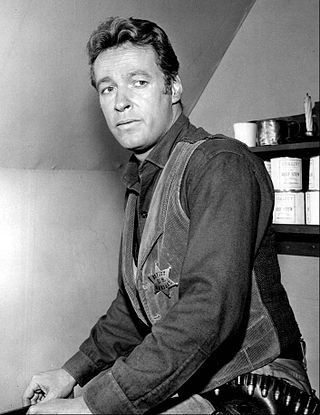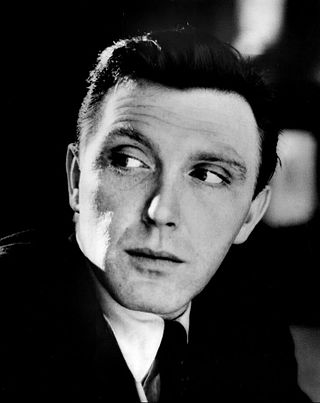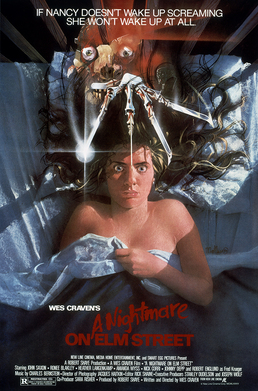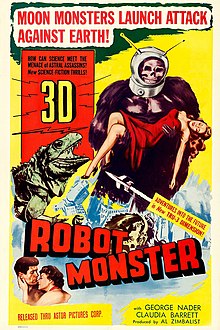
Forbidden Planet is a 1956 American science fiction film from Metro-Goldwyn-Mayer, produced by Nicholas Nayfack, and directed by Fred M. Wilcox from a script by Cyril Hume that was based on an original film story by Allen Adler and Irving Block. It stars Walter Pidgeon, Anne Francis, and Leslie Nielsen. Shot in Eastmancolor and CinemaScope, it is considered one of the great science fiction films of the 1950s, a precursor of contemporary science fiction cinema. The characters and isolated setting have been compared to those in William Shakespeare's The Tempest, and the plot contains certain happenings analogous to the play, leading many to consider it a loose adaptation.

Science fiction is a film genre that uses speculative, fictional science-based depictions of phenomena that are not fully accepted by mainstream science, such as extraterrestrial lifeforms, spacecraft, robots, cyborgs, mutants, interstellar travel, time travel, or other technologies. Science fiction films have often been used to focus on political or social issues, and to explore philosophical issues like the human condition.

Elmer Bernstein was an American composer and conductor. In a career that spanned over five decades, he composed "some of the most recognizable and memorable themes in Hollywood history", including over 150 original film scores, as well as scores for nearly 80 television productions. For his work, he received an Academy Award for Thoroughly Modern Millie (1967) and Primetime Emmy Award. He also received seven Golden Globe Awards, five Grammy Awards, and two Tony Award nominations.

Crow The Robot is a fictional character from the American science fiction comedy television series Mystery Science Theater 3000 (MST3K). Crow is a robot, who, along with others, ridicules poor-quality B to Z movies.

Hans Georg Conried Jr. was an American actor and comedian. He was known for providing the voices of George Darling and Captain Hook in Walt Disney's Peter Pan (1953), Snidely Whiplash in Jay Ward's Dudley Do-Right cartoons, Professor Waldo P. Wigglesworth in Ward's Hoppity Hooper cartoons, was host of Ward's live-action "Fractured Flickers" show and Professor Kropotkin on the radio and film versions of My Friend Irma. He also appeared as Uncle Tonoose on Danny Thomas' sitcom Make Room for Daddy, and twice on I Love Lucy & Mad Hatter along with Daw Butler, Dolores Starr, Stanley Adams, Francis Condie Baxter & Cheryl Callaway in The Alphabet Conspiracy (1959).

Forrest Meredith Tucker was an American actor in both movies and television who appeared in nearly a hundred films. Tucker worked as a vaudeville straight man at the age of fifteen. A mentor provided funds and contacts for a trip to California, where party hostess Cobina Wright persuaded guest Wesley Ruggles to give Tucker a screen test because of Tucker's photogenic good looks, thick wavy hair and height of six feet, five inches.

Russell David Johnson was an American actor. He played Professor Roy Hinkley in Gilligan's Island and Marshal Gib Scott in Black Saddle.

Robert Lansing was an American stage, film, and television actor.

Elmer Calvin "Hank" Patterson was an American actor and musician. He is known foremost for playing two recurring characters on three television series - stableman Hank Miller on Gunsmoke and farmer Fred Ziffel on both Petticoat Junction and Green Acres.

Francis Healey Albertson was an American actor who had supporting roles in films such as It's a Wonderful Life (1946) and Psycho (1960).

A Nightmare on Elm Street is a 1984 American supernatural slasher film written and directed by Wes Craven and produced by Robert Shaye. It is the first installment in the A Nightmare on Elm Street franchise and stars Heather Langenkamp, John Saxon, Ronee Blakley, Robert Englund as Freddy Krueger, and Johnny Depp in his film debut. The film's plot concerns a group of teenagers who are targeted by Krueger, an undead child killer who can murder people through their dreams, as retribution against their parents who burned him alive.

Spider-Man, also referred to as Japanese Spider-Man or Toei Spider-Man, is a Japanese live-action tokusatsu super hero television series produced by Toei Company, loosely based on Marvel Comics' character of the same name via a contract that was negotiated by producer Gene Pelc. The series lasted 41 episodes, which aired on Tokyo Channel 12 from May 17, 1978, to March 14, 1979. A theatrical episode was shown in the Toei Manga Matsuri film festival on July 22, 1978. From March 5 to December 24, 2009, Marvel uploaded English subtitled versions of all 41 episodes on their website.
The Cape Canaveral Monsters is a 1960 independent American black-and-white science-fiction film, produced by Lionel Dichter and Richard Greer, and written and directed by Phil Tucker. It stars Katherine Victor, Jason Johnson, Scott Peters and Linda Connell, Though planned as a theatrical feature, it was ultimately released directly to television. The movies deals with two extraterrestrials who have come to earth to "transmit" healthy, living humans, especially women, back to their home planet and to disrupt rockets launched from Cape Canaveral. It was made shortly before the start of the USA's crewed space program and has been categorized by a reviewer as a later entry in the "reds-under-the-beds," fear-of-communism films that were often part of sci-fi during the 1950s

George Garfield Nader, Jr. was an American actor and writer of Lebanese descent. He appeared in a variety of films from 1950 to 1974, including Sins of Jezebel (1953), Congo Crossing (1956), and The Female Animal (1958). During this period, he also did episodic television and starred in several series, including NBC's The Man and the Challenge (1959–60). In the 1960s he made several films in Germany, playing FBI agent Jerry Cotton. He is remembered for his first starring role, in the low-budget 3-D sci-fi film Robot Monster (1953), known as "one of the worst films ever made.”

Roy Barcroft was an American character actor famous for playing villains in B-Westerns and other genres. From 1937 to 1957, he appeared in more than 300 films for Republic Pictures. Film critic Leonard Maltin acclaimed Barcroft as "Republic Pictures' number one bad guy".
Bob Burns is an American actor, consultant, producer, archivist and historian of props, costumes, and other paraphernalia from science fiction, fantasy, and horror motion pictures. He is notable for his work with and collection of movie props, particularly from horror and science-fiction movies. He has also had numerous acting roles, including Tracy the Gorilla in the 1975 television show The Ghost Busters.

Miss Robin Crusoe is a 1953 American low-budget adventure film produced and directed by Eugene Frenke and starring Amanda Blake, George Nader and Rosalind Hayes. One of many film variations of Daniel Defoe's 1719 novel Robinson Crusoe, it features a female castaway.

Claudia Barrett was an American television and film actress.
Gregory Moffett is an American former child actor who appeared in several films and television series in the 1950s. His older sister, Sharyn Moffett, was a child actress. Their parents were also in the entertainment business. In 1949, he signed a seven-year long film contract with Paramount, earning $125 per week. He was in films such as Let's Dance (1950), and Robot Monster (1953), which is regarded as one of the worst movies ever made. He played Johnny, the professor's only son. He also appeared in television shows like Adventures of Superman.















